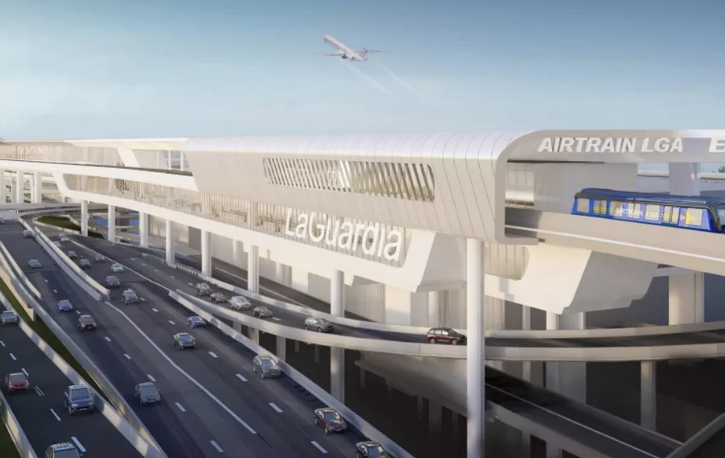OPINION: A Tiny Federal Rule Change Just Gave NYC the Power to Build Real Rail to Airports


Helping travelers access New York airports should be easy in a city with so much transit. Yet getting to JFK and Newark require a transfer from the subway or commuter rail lines to a people mover, which discourages too many travelers from using public transit.
This could change with a new ruling by the Federal Aviation Administration that would allow the Port Authority to modify its current plans for a people mover at LaGuardia and allow the #7 subway or the Long Island Rail Road to go directly to LaGuardia with no transfer.
Here’s the background: For years, the Port Authority has been collecting surcharges on airline ticket sales — and FAA rules forbade the agency from using those funds on anything except conveyances that only served airport needs. The funds could not be used for any transport service that commingled with existing or new public rail lines.
But the FAA‘s Jan. 12 ruling now allows the Port Authority and MTA to consider shelving its unpopular “wrong way AirTrain” link between LaGuardia and the 7 and LIRR stations at Willets Point and consider creating a new subway or LIRR link directly to the airport.
Over the years, some advocates have complained that the proposed AirTrain route takes Manhattan-bound passengers is too far to the east before they can transfer — or, worse, routes them to an LIRR line (the Port Washington branch) that doesn’t connect to the myriad trains at Jamaica. Some of those advocates believe the best solution would simply be to extend the existing N train from its Astoria/Ditmars Blvd. terminus to LaGuaria. The reality is, the Port Authority and the MTA did present plans for an extended Astoria Line many years ago. But time and again, the residential communities said no.

Perhaps that debate could be kickstarted, but there’s another answer: The Port Authority has already designed a route for the AirTrain along the Grand Central Parkway to Willets Point, and I would argue that this effort should not be tossed aside.
Running either the #7 subway or LIRR’s Port Washington branch directly into the new terminal at LaGuardia would eliminate the need for travelers to transfer to a separate AirTrain and still provide a reasonable 25- to 35-minute ride to Manhattan.
Extending the #7 might not be so easy. Main Street Flushing is already one of the busiest stations in the subway system with 60,000 daily passengers. To divert any service from Main Street in favor of LaGuardia would not be fair to current subway riders, but options should be considered.
One option for the morning rush hour would be to have a local train every 15 minutes operate from LGA and in the afternoon operate all express trains to Main Street, and then backtrack to LGA. This would still only be a 35-minute ride from Grand Central.
The LIRR’s Port Washington Branch, however, is more favorable because it would have fewer station stops to Manhattan and the line has spare capacity, even more so when the LIRR’s East Side Access opens.
Trains could operate every 15 minutes from Grand Central and meet Port Washington-bound trains from Penn Station at Willets Point while the train operator changes ends, then operates to LGA. This ride would take about 27 minutes, even with changing ends, with a drop-back crew.
Another option would be to loop the LIRR east of Willets Point adjacent to the Van Wyck and under Roosevelt Avenue, back around to LGA. The only problem with this would be if the new residential developments in Flushing find any objection. Objections would equal delay and no promise of approval. That is what makes the current AirTrain route so valuable — it already has the go-ahead.
Also, using the LIRR could become a part of a longer-term regional transport strategy to provide access beyond the city to include regional destinations (something the Regional Plan Association has promoted for many years).
The FAA’s ruling on how funds raised for ground access can be spent was long overdue. It gives the Port Authority and the MTA flexibility to design better and more direct access to LaGuardia using either the #7 or LIRR. The JFK AirTrain has become more popular than the Port Authority thought it might be, despite the transfers required at Jamaica and Howard Beach stations. We can only imagine what might have been having the subway or LIRR been allowed to directly access JFK.
The FAA’s ruling regarding how the Port Authority funds rail access improvements presents a new opportunity to make a one-seat ride between LaGuardia and Manhattan possible. It would be foolish to underestimate the work the Port Authority has done to get the new AirTrain plans to this point, but substituting the #7 or the LIRR is worth it for travelers who would consider taking a train to the airport — if it was easy.
Bob Previdi is a transit consultant and a former planner and spokesman for NYC Transit.





